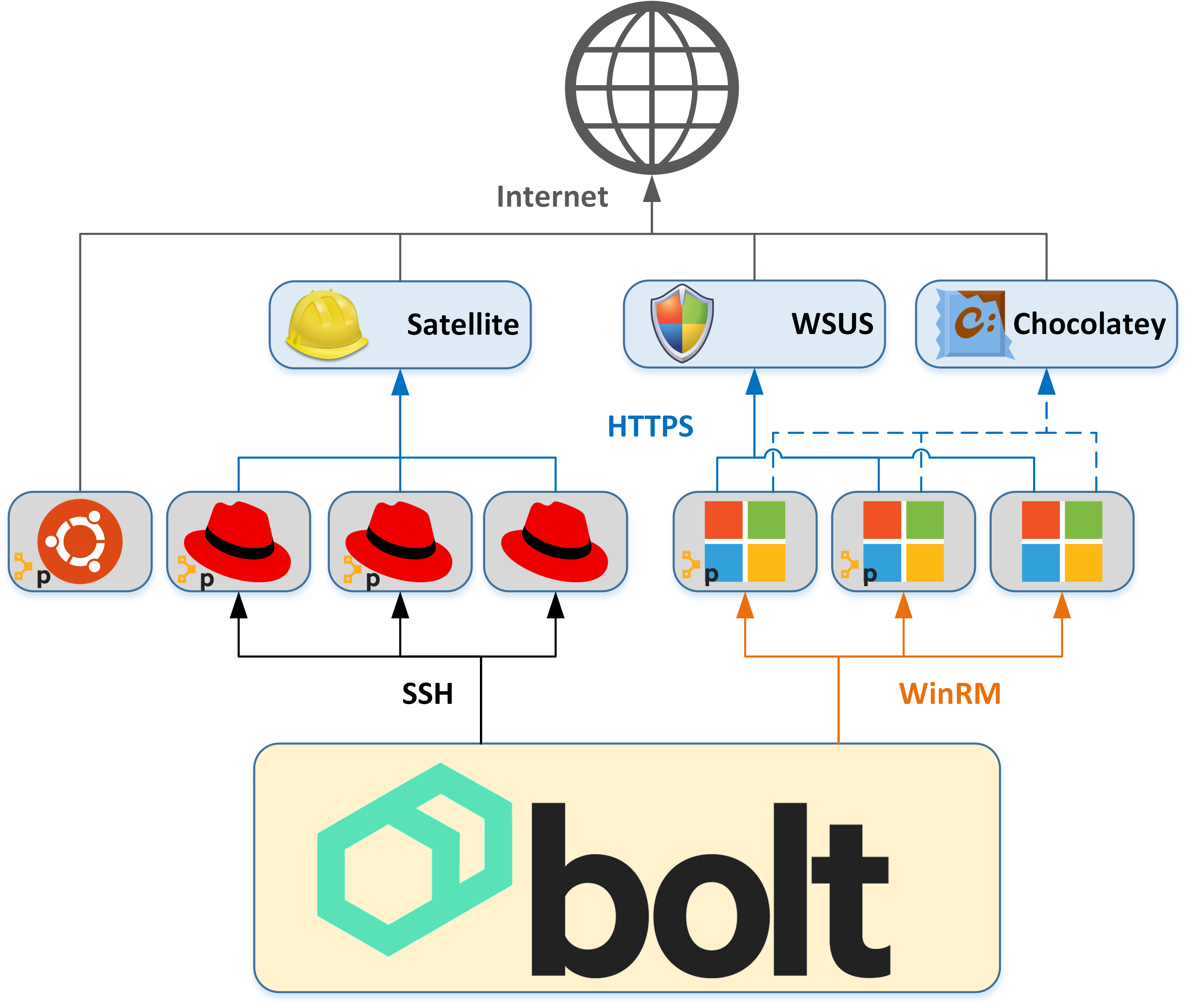- Module description
- Setup
- Architecture
- Design
- Patching Workflow
- Usage
- Configuration Options
- Reference
- Limitations
- Development
- Contributors
A framework for building patching workflows. This module is designed to be used as building blocks for complex patching environments of Windows and Linux (RHEL, Ubuntu) systems.
No Puppet agent is required on the end targets. The node executing the patching will need to
have bolt installed.
Module makes heavy use of bolt, you'll need to install it to get started. Install instructions are here.
If you want to use the patching::snapshot_vmware plan/function then you'll
need the rbvmomi gem installed in the
bolt ruby environment:
/opt/puppetlabs/bolt/bin/gem install --user-install rbvmomicat << EOF >> ~/.puppetlabs/bolt/Puppetfile
mod 'puppetlabs/stdlib'
mod 'encore/patching'
EOF
bolt puppetfile install
bolt plan run patching::available_updates --targets group_a
# install rbvmomi for VMware snapshot support
/opt/puppetlabs/bolt/bin/gem install --user-install rbvmomiThis module is designed to work in enterprise patching environments.
Assumptions:
- RHEL targets are registered to Satellite / Foreman or the internet
- Ubuntu targets are registered to Landscape or the internet
- Windows targets are registered to WSUS and Chocolatey (optional)
Registration to a central patching server is preferred for speed of software downloads and control of phased patching promotions.
At some point in the future we will include tasks and plans to promote patches through these central patching server tools.
patching is designed around bolt tasks and plans.
Individual tasks have been written to accomplish targeted steps in the patching process.
Examples: patching::available_updates is used to check for available updates on targets.
Plans are then used to pretty up output and tie tasks together.
This way end users can use the tasks and plans as build blocks to create their own custom patching workflows (we all know, there is no such thing as one size fits all).
For more info on tasks and plans, see the Usage and Reference sections.
Going further, many of the settings for the plans are configurable by setting vars
on your groups in the bolt inventory file.
For more info on customizing settings using vars, see the Configuration Options section
Our default patching workflow is implented in the patching plan patching/init.pp.
This workflow consists of the following phases:
- Organize inventory into groups, in the proper order required for patching
- For each group...
- Check for available updates
- Disable monitoring
- Snapshot the VMs
- Pre-patch custom tasks
- Update the host (patch)
- Post-patch custom tasks
- Reboot that require a reboot
- Delete snapshots
- Enable monitoring
This will reach out to all targets in group_a in your inventory and check for any available
updates through the system's package manager:
- RHEL = yum
- Ubuntu = apt
- Windows = Windows Update + Chocolatey (if installed)
bolt plan run patching::available_updates --targets group_aPrior to performing the snapshotting and patching steps, the plan will disable monitoring alerts in SolarWinds (by default).
This plan/task utilizes the remote transport []
bolt plan run patching::monitoring_solarwinds --targets group_a action=disable' monitoring_target=solarwindsThis plan will snapshot all of the hosts in VMware. The name of the VM in VMware is assumed to
be the uri of the node the inventory file.
/opt/puppetlabs/bolt/bin/gem install rbvmomi
bolt plan run patching::snapshot_vmware --targets group_a action='create' vsphere_host='vsphere.domain.tld' vsphere_username='xyz' vsphere_password='abc123' vsphere_datacenter='dctr1'This plan is designed to perform custom service checks and shutdown actions before
applying patches to a node.
If you have custom actions that need to be perform prior to patching, place them in the
pre_update scripts and this plan will execute them.
Best practice is to define and distribute these scripts as part of your normal Puppet code
as part of othe role for that node.
bolt plan run patching::pre_update --targets group_aBy default this executes the following scripts (targets where the script doesn't exist are ignored):
- Linux =
/opt/patching/bin/pre_update.sh - Windows =
C:\ProgramData\patching\pre_update.ps1
An easy way to deploy pre/post patching scripts is via the patching Puppet manifest or the patching::script resource.
Using the patching class:
class {'patching':
scripts => {
'pre_patch.sh': {
content => template('mymodule/patching/custom_app_post_patch.sh'),
},
'post_patch.sh': {
source => 'puppet:///mymodule/patching/custom_app_post_patch.sh',
},
},
}Via patching::script resources:
patching::script { 'custom_app_pre_patch.sh':
content => template('mymodule/patching/custom_app_pre_patch.sh'),
}
patching::script { 'custom_app_post_patch.sh':
source => 'puppet:///mymodule/patching/custom_app_post_patch.sh',
}Or via Hiera:
patching::scripts:
custom_app_pre_patch.sh:
source: 'puppet:///mymodule/patching/custom_app_pre_patch.sh'
custom_app_post_patch.sh:
source: 'puppet:///mymodule/patching/custom_app_post_patch.sh'
Organize the inventory into groups:
patching::ordered_groups
Then, for each group:
patching::cache_updatespatching::available_updatespatching::snapshot_vmware action='create'patching::pre_updatepatching::updatepatching::post_updatepatching::reboot_requiredpatching::snapshot_vmware action='delete'
bolt plan run patching --targets group_aWhen executing patching with Puppet Enterprise Bolt will use the pcp transport.
This transport has a default timeout of 1000 seconds. Windows patching is MUCH
slower than this and the timeouts will need to be increased.
If you do not modify this default timeout, you may experience the following error
in the patching::update task or any other long running task:
Starting: task patching::update on windowshost.company.com
Finished: task patching::update with 1 failure in 1044.63 sec
The following hosts failed during update:
[{"target":"windowshost.company.com","action":"task","object":"patching::update","status":"failure","result":{"_output":"null","_error":{"kind":"puppetlabs.tasks/task-error","issue_code":"TASK_ERROR","msg":"The task failed with exit code unknown","details":{"exit_code":"unknown"}}},"node":"windowshost.company.com"}]Below is an example bolt.yaml with the settings modified:
---
pcp:
# 2 hours = 120 minutes = 7,200 seconds
job-poll-timeout: 7200For a complete reference of the available settings for the pcp transport see
bolt configuration reference
documentation.
This module allows many aspects of its runtime to be customized using configuration options in the inventory file.
For details on all of the available configuration options, see REFERENCE_CONFIGURATION.md
Example: Let's say we want to prevent some targets from rebooting during patching.
This can be customized with the patching_reboot_strategy variable in inventory:
groups:
- name: no_reboot_nodes
vars:
patching_reboot_strategy: 'never'
targets:
- abc123.domain.tld
- def4556.domain.tldSee REFERENCE.md
This module has been tested on the following operating systems:
- Windows
- 2008
- 2012
- 2016
- RHEL
- 6
- 7
- 8
- Ubuntu
- 16.04
- 18.04
See DEVELOPMENT.md





